Chapter 2 Overview of the Microstructure of the Nervous System
The nervous system has two major divisions, the central nervous system (CNS) and the peripheral nervous system (PNS). The CNS consists of the brain and spinal cord and contains the majority of neuronal cell bodies. The PNS includes all nervous tissue outside the CNS and is subdivided into the cranial and spinal nerves, autonomic nervous system (ANS) (including the enteric nervous system (ENS) of the gut wall) and special senses (taste, olfaction, vision, hearing and balance). It is composed mainly of the axons of sensory and motor neurones that pass between the CNS and the body. However, the ENS contains as many intrinsic neurones in its ganglia as the entire spinal cord, is not connected directly to the CNS, and may be considered separately as a third division of the nervous system.
The CNS is derived from the neural tube (Ch. 3). The cell bodies of neurones are often grouped together in areas termed nuclei, or they may form more extensive layers or masses of cells collectively called grey matter. Neuronal dendrites and synaptic activity are mostly confined to areas of grey matter, and they form part of its meshwork of neuronal and glial processes that is collectively termed the neuropil (Fig. 2.1). Their axons pass into bundles of nerve fibres that tend to be grouped separately to form tracts. In the spinal cord, cerebellum, cerebral cortices and some other areas, concentrations of tracts constitute the white matter, so called because the axons are often ensheathed in myelin, which is white when fresh (see Figs. 8.16, 8.19).
The PNS is composed of the axons of motor neurones situated inside the CNS and the cell bodies of sensory neurones (grouped together as ganglia) and their processes. Sensory cells in dorsal root ganglia give off both centrally and peripherally directed processes; there are no synapses on their cell bodies. Ganglionic neurones of the ANS receive synaptic contacts from various sources. Neuronal cell bodies in peripheral ganglia are all derived embryologically from cells that migrate from the neural crest (Ch. 3).
When the neural tube is formed during prenatal development, its walls thicken greatly but do not completely obliterate the cavity within. The latter remains in the spinal cord as the narrow central canal, and in the brain it becomes greatly expanded to form a series of interconnected cavities called the ventricular system. In the fore- and hindbrains, parts of the neural tube roof do not generate nerve cells but become thin, folded sheets of secretory tissue that are invaded by blood vessels and are called the choroid plexuses. The plexuses secrete cerebrospinal fluid (CSF), which fills the ventricles and subarachnoid spaces (Ch. 4). and penetrates the intercellular spaces of the brain and spinal cord to create their interstitial fluid. The CNS has a rich blood supply, which is essential to sustain its high metabolic rate. The blood–brain barrier places considerable restrictions on the substances that can diffuse from the blood stream into the nervous tissue.
Neurones
Neurones exhibit great variability in size (cell bodies range from 5 to 100 µm diameter) and shape. Their surface areas are extensive because most neurones display numerous narrow, branched cell processes. They usually have a rounded or polygonal cell body (perikaryon or soma). This is a central mass of cytoplasm that encloses a nucleus and gives off long, branched extensions, with which most intercellular contacts are made. Typically, one of these processes, the axon, is much longer than the others, the dendrites (Fig. 2.2). Dendrites conduct electrical impulses toward a soma, whereas axons conduct impulses away from it.
Neurones can be classified according to the number and arrangement of their processes. Multipolar neurones (Fig. 2.3; see also Fig. 16.9) are common; they have an extensive dendritic tree, which arises either from a single primary dendrite or directly from the soma, and a single axon. Bipolar neurones, which typify neurones of the special sensory systems (e.g., retina), have only a single dendrite that emerges from the soma opposite the axonal pole. Unipolar neurones that transmit general sensation (e.g., dorsal root ganglion neurones) have a single short process that bifurcates into peripheral and central processes, an arrangement that arises by the fusion of the proximal axonal and dendritic processes of a bipolar neurone during development.
Neurones are postmitotic cells and, with few exceptions, are not replaced when lost.
Soma
The cytoplasm of a typical soma (see Fig. 2.2) is rich in rough and smooth endoplasmic reticulum and free polyribosomes, which reveals a high level of protein synthetic activity. Free polyribosomes often congregate in large groups associated with the rough endoplasmic reticulum. These aggregates of RNA-rich structures are visible by light microscopy as basophilic Nissl (chromatin) bodies or granules (Fig. 2.4). They are more obvious in large, highly active cells such as spinal motor neurones, which contain large stacks of rough endoplasmic reticulum and polyribosome aggregates. Maintenance and turnover of cytoplasmic and membranous components are necessary in all cells; the huge total volume of cytoplasm within the soma and processes of many neurones requires a considerable commitment of protein synthetic machinery. Neurones synthesize other proteins (e.g., enzyme systems) involved in the production of neurotransmitters and in the reception and transduction of incoming stimuli. Various transmembrane channel proteins and enzymes are located at the surfaces of neurones, where they are associated with ion transport. The apparatus for protein synthesis (including RNA and ribosomes) occupies the soma and dendrites but is usually absent from axons.
The neuronal cytoskeleton is a prominent feature of its cytoplasm, and it gives shape, strength and rigidity to the dendrites and axons. Neurofilaments (the intermediate filaments of neurones) and microtubules are abundant; they occur in the soma and extend along dendrites and axons, in proportions that vary with the type of neurone and cell process. Bundles of neurofilaments constitute neurofibrils, which can be seen by light microscopy in silver stained sections. Neurofilaments are heteropolymers of proteins assembled from three polypeptide subunits: NF-L (68 kDa), NF-M (160 kDa) and NF-H (200 kDa). NF-M and NF-H have long C-terminal domains that project as side arms from the assembled neurofilament and bind to neighbouring filaments. They can be heavily phosphorylated, particularly in the highly stable neurofilaments of mature axons, and are thought to give axons their tensile strength. Some axons are almost filled by neurofilaments. Dendrites usually have more microtubules than axons.
Dendrites
Dendrites are highly branched, usually short processes that project from the soma (see Fig. 2.2). The branching patterns of many dendritic arrays are probably established by random adhesive interactions between dendritic growth cones and afferent axons that occur during development. There is an overproduction of dendrites in early development, which is pruned in response to functional demand as the individual matures and information is processed through the dendritic tree. There is evidence that dendritic trees may be plastic structures throughout adult life, expanding and contracting as the traffic of synaptic activity varies through afferent axodendritic contacts. Groups of neurones with similar functions have a similar stereotypical tree structure (Fig. 2.5), suggesting that the branching patterns of dendrites are important determinants of the integration of afferent inputs that converge on the tree.
Dendrites differ from axons in many respects. They represent the afferent rather than the efferent system of the neurone, and they receive both excitatory and inhibitory axodendritic contacts. They may also make dendrodendritic and dendrosomatic connections (see Fig. 2.8), some of which are reciprocal. Synapses occur either on small projections called dendritic spines or on the smooth dendritic surface. Dendrites contain ribosomes, smooth endoplasmic reticulum, microtubules, neurofilaments, actin filaments and Golgi complexes. The neurofilament proteins of dendrites are poorly phosphorylated. Dendrite microtubules express the microtubule-associated protein (MAP-2) almost exclusively, in comparison with axons.
Axons
The axon originates either from the soma or from the proximal segment of a dendrite, at a specialized region called the axon hillock (see Fig. 2.2), which is free of Nissl granules. Action potentials are initiated here. The axonal plasma membrane (axolemma) is undercoated at the hillock by a concentration of cytoskeletal molecules, including spectrin and actin fibrils, which are thought to be important in anchoring numerous voltage-sensitive channels to the membrane. The axon hillock is unmyelinated and often participates in inhibitory axo-axonal synapses. This region of the axon is unique because it contains ribosomal aggregates immediately below the postsynaptic membrane.
When present, myelin begins at the distal end of the axon hillock. Myelin thickness and internodal segment lengths are positively correlated with axon diameter. In the PNS unmyelinated axons are embedded in Schwann cell cytoplasm; in the CNS they lie free in the neuropil. Nodes of Ranvier are specialized constricted regions of myelin-free axolemma where action potentials are generated and where an axon may branch. The density of sodium channels in the axolemma is highest at the nodes of Ranvier and very low along internodal membranes. In contrast, sodium channels are spread more evenly within the axolemma of unmyelinated axons. Fast potassium channels are also present in the paranodal regions of myelinated axons. Fine processes of glial cytoplasm (astrocyte in the CNS, Schwann cell in the PNS) surround the nodal axolemma. The terminals of an axon are unmyelinated. They expand into presynaptic boutons, which may form connections with axons, dendrites, neuronal somata or, in the periphery, muscle fibres, glands and lymphoid tissue. They may themselves be contacted by other axons, forming axo-axonal presynaptic inhibitory circuits. Further details of neuronal microcircuitry are given in Kandel and Schwartz (2000).
Axoplasmic Flow
Rapid flow depends on microtubules. Vesicles with side projections line up along microtubules and are transported along them by their side arms. Two microtubule-based motor proteins with ATPase activity are involved in fast transport. Kinesin family proteins are responsible for the fast component of anterograde transport, and cytoplasmic dynein is responsible for retrograde transport. Fast anterograde transport carries vesicles, including synaptic vesicles containing neurotransmitters, from the soma to the axon terminals. Retrograde axonal transport accounts for the flow of mitochondria, endosomes and lysosomal autophagic vacuoles from the axon terminals into the soma. Retrograde transport mediates the movement of neurotrophic viruses (e.g., herpes zoster, rabies, polio) from peripheral terminals and their subsequent concentration in the neuronal soma.
Synapses
The patterns of axonal termination vary considerably. A single axon may synapse with one neurone, such as climbing fibres ending on cerebellar Purkinje neurones; more often, it synapses with many, such as cerebellar parallel fibres, which provide an extreme example of this phenomenon. In synaptic glomeruli (e.g., in the olfactory bulb) and synaptic cartridges, groups of synapses between two or more neurones form interactive units encapsulated by neuroglia (Fig. 2.6).
Classification of Chemical Synapses
Chemical synapses have an asymmetric structural organization (Figs 2.7, 2.8), in keeping with the unidirectional nature of their transmission. Typical chemical synapses share a number of important features. They all display an area of presynaptic membrane apposed to a corresponding postsynaptic membrane; the two are separated by a narrow (20 to 30 nm) gap, the synaptic cleft. Synaptic vesicles containing neurotransmitters lie on the presynaptic side, clustered near an area of dense material on the cytoplasmic aspect of the presynaptic membrane. A corresponding region of submembrane density is present on the postsynaptic side. Together these define the active zone, the area of the synapse where neurotransmission takes place.
Chemical synapses can be classified according to a number of different parameters, including the neuronal regions forming the synapse, their ultrastructural characteristics, the chemical nature of their neurotransmitters and their effects on the electrical state of the postsynaptic neurone. The classification described here is limited to associations between neurones. Neuromuscular junctions share many (although not all) of these parameters and are often referred to as peripheral synapses. They are described separately in Chapter 22.
Synapses can occur between almost any surface regions of the participating neurones. The most common type occurs between an axon and either a dendrite or a soma, when the axon is expanded as a small bulb or bouton (see Figs. 2.7, 2.8). This may be a terminal of an axonal branch (terminal bouton) or one of a row of bead-like endings, with the axon making contact at several points and often with more than one neurone (bouton de passage). Boutons may synapse with dendrites, including dendritic spines or the flat surface of a dendritic shaft; a soma, usually on its flat surface, but occasionally on spines; the axon hillock and the terminal boutons of other axons.
Ultrastructurally, synaptic vesicles may be internally clear or dense and of different sizes (loosely categorized as small or large) and shape (round, flat or pleomorphic, i.e., irregularly shaped). The submembranous densities may be thicker on the postsynaptic than on the presynaptic side (asymmetric synapses) or equivalent in thickness (symmetric synapses). Synaptic ribbons are found at sites of neurotransmission in the retina and inner ear. They have a distinctive morphology, in that the synaptic vesicles are grouped around a ribbon- or rod-like density oriented perpendicular to the cell membrane (see Fig. 2.8).
The neurosecretory endings found in various parts of the brain and in neuroendocrine glands have many features in common with presynaptic boutons. They all contain peptides or glycoproteins within dense-core vesicles of characteristic size and appearance. These are often ellipsoidal or irregular in shape and relatively large; for example, oxytocin and vasopressin vesicles in the neurohypophysis may be up to 200 nm across.
Mechanisms of Synaptic Activity
Synaptic activation begins with the arrival of one or more action potentials at the presynaptic bouton, which causes the opening of voltage-sensitive calcium channels in the presynaptic membrane. The response time in typical fast-acting synapses is then very rapid; classic neurotransmitter (e.g., ACh) is released in less than a millisecond, which is faster than the activation time of a classic second messenger system on the presynaptic side. The influx of calcium activates Ca2+-dependent protein kinases. This uncouples synaptic vesicles from a spectrin–actin meshwork within the presynaptic ending, to which they are bound via synapsins I and II. The vesicles dock with the presynaptic membrane, through processes not yet fully understood, and their membranes fuse to open a pore through which neurotransmitter diffuses into the synaptic cleft.
Neurotransmitters
Until recently the molecules known to be involved in chemical synapses were limited to a fairly small group of classic neurotransmitters—ACh, noradrenaline, adrenaline, dopamine and histamine—all of which had well-defined rapid effects on other neurones, muscle cells or glands. However, many synaptic interactions cannot be explained on the basis of classic neurotransmitters, and it now appears that other substances, particularly some amino acids such as glutamate, glycine, aspartate, GABA and the monoamine serotonin, also function as transmitters. Substances first identified as hypophysial hormones or as part of the dispersed neuroendocrine system of the alimentary tract can be detected widely throughout the CNS and PNS, often associated with functionally integrated systems. Many of these are peptides: more than 50 (together with other candidates) function mainly as neuromodulators and influence the activities of classic transmitters.
Amino acids
The best understood amino acid is GABA, which is a major inhibitory transmitter released at the terminals of local circuit neurones within the brain stem and spinal cord (e.g., recurrent inhibitory Renshaw loop; Ch. 8), cerebellum (as the main transmitter of Purkinje neurones) and elsewhere. It is stored in flattened or pleomorphic vesicles within symmetric synapses; it may be inhibitory to the postsynaptic neurone, or it may mediate either presynaptic inhibition or facilitation, depending on the synaptic arrangement.















